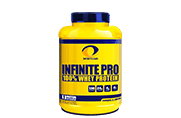

Whey Protein + HMB= Increased Muscle Mass
Table of Contents
High Volume Bodybuilders Need More than Whey!
By Robbie Durand
Whey & HMB Enhances Muscle Recovery
When HMB first hit the bodybuilding market, it was going to be the next big thing in sports supplementation, next to creatine and whey protein. Beta-hydroxy-beta-methylbutyrate (HMB) is a metabolite of leucine, a branched-chain amino acid found in whey protein that activates key protein synthesis enzymes post-exercise. Recent studies of HMB supplementation support its ability to encourage synthesis and reduce breakdown of muscle protein.
In 2008, when researchers administered HMB alone to resistance trained athletes, biochemical markers of muscle protein turnover and muscle damage were also unaffected by HMB supplementation. So that’s when the negative responses started pouring in on the use of HMB, but when you’re looking at the peer review process, a single study does not mean a supplement is useless, in fact, even creatine and whey protein have had adverse outcomes, but that does not mean you should discard them. The positive studies supporting the use of HMB are much abundant than the negative studies.
Many studies have indicated that HMB supplementation may elicit several ergogenic benefits, including anti-catabolic, anabolic, and lipolytic effects. HMB is classified as a recovery agent, along with whey protein, and carbohydrates. One study reported that HMB stabilized cell membranes resulting in reduced circulating creatine kinase, which is a marker for muscle damage. Carbohydrates can enhance muscle glycogen levels and glycogen depletion results in enhanced activity of the catabolic gene Interleukin-6. In runners, carbohydrate supplementation can reduce Interleukin-6 responses following long-distance running. Whey protein has been shown to be an effective supplement, resistance training protocols with high volume, frequency, and glycolytic demands may place greater stress on recovery than the traditional workouts that have been used to study whey protein. Further, athletes may fail to balance training and recovery as they strive for maximal performance. When excessive stress is placed on the body’s recovery process, which can no longer compensate, reductions in strength, over-training syndrome. Researchers wanted to compare HMB, whey protein, and some carbohydrates before, during, and after exercise.
Researchers had resistance-trained men ingest a whey protein, HMB, and isomaltulose supplement (Isomaltulose is a slow-release carbohydrate believed to prevent glycogen depletion) or just whey protein at intervals before, during, and following three consecutive days of intense resistance exercise. Treatment outcomes were evaluated using blood-based muscle damage markers and hormones, perceptual measures of muscle soreness, and counter-movement jump performance.
The supplement contained 260 kcal, 20 grams of whey protein, 1.5 g HMB, 41 g carbohydrate, 2 g fat) or whey protein (100 kcal, 20 g protein, 2.5 g carbohydrate, 1 g fat).
 The workout sequence included heavy resistance exercise (day 1) and metabolic resistance exercise (days 2 and 3) and was specially designed to provide “excessive demands” on the recovery process. Researchers observed reductions in markers of muscle damage and improved athletic performance in subjects taking the whey protein, HMB, and carbohydrate supplement, suggesting that whey protein supplementation can be optimized for muscle recovery during intense conditioning by adding HMB and a slow-release carbohydrate. The workout sequence included heavy resistance exercise (day 1) and metabolic resistance exercise (days 2 and 3) and was specially designed to provide “excessive demands” on the recovery process. Researchers observed reductions in markers of muscle damage and improved athletic performance in subjects taking the whey protein, HMB, and carbohydrate supplement, suggesting that whey protein supplementation can be optimized for muscle recovery during intense conditioning by adding HMB and a slow-release carbohydrate. |
The primary finding of this study is that when high loads and short periods are used during high-frequency resistance exercise, the addition of HMB and a slow-release carbohydrate to whey protein is more efficient than whey protein alone at promoting recovery. This was evidenced not only by reductions in indirect markers muscle damage but by reductions in muscle soreness and improved physical performance. When resistance training combines high training frequencies with high loads and short rest periods, a greater demand is placed on the body’s recovery processes, which increases the need for supplementation. Although whey protein alone has been shown to be an effective supplement, the addition of HMB and a slow-release carbohydrate further mediates the recovery process, as evidenced by reduced muscle damage, lower perceived soreness, and improved athletic performance.
This means that when trying to make optimal gains in strength and size, bodybuilders can benefit from the use of whey protein, HMB, and carbohydrates.
| Kraemer WJ, Hooper DR, Szivak TK, Kupchak BR, Dunn-Lewis C, Comstock BA, Flanagan SD, Looney DP, Sterczala AJ, DuPont WH, Pryor JL, Luk HY, Maladoungdock J, McDermott D, Volek JS, Maresh CM. The addition of beta-hydroxy-beta-methylbutyrate and isomaltulose to whey protein improves recovery from highly demanding resistance exercise. J Am Coll Nutr. 2015;34(2):91-9. |
Wilson GJ, Wilson JM, Manninen AH. Effects of beta-hydroxy-beta-methylbutyrate (HMB) on exercise performance and body composition across varying levels of age, sex, and training experience: A review. Nutrition & Metabolism. 2008;5:1. doi:10.1186/1743-7075-5-1.
Knitter AE, Panton L, Rathmacher JA, Petersen A, Sharp R. Effects of β-hydroxy-β-methylbutyrate on muscle damage after a prolonged run. J Appl Physiol. 2000;89:1340–1344.
Jowko E, Ostaszewski P, Jank M, Sacharuk J, Zieniewicz A, Wilczak J, Nissen S. Creatine and β-hydroxy-β-methylbutyrate (HMB) additively increase lean body mass and muscle strength during a weight-training program. Nutr. 2001;17:558–566. doi: 10.1016/S0899-9007(01)00540-8.
Gallagher PM, Carrithers JA, Godard MP, Schulze KE, Trappe S. β-hydroxy-β-methylbutyrate ingestion, part I: Effects on strength and fat free mass. Med Sci Sports Exerc. 2000;32:2109–2115.
Paulsen G, Mikkelsen UR, Raastad T, Peake JM: Leucocytes, cytokines and satellite cells: what role do they play in muscle damage and regeneration following eccentric exercise? Exerc Immunol Rev 18:42–97, 2012.
Keller C, Steensberg A, Pilegaard H, Osada T, Saltin B, Pedersen BK, Neufer PD: Transcriptional activation of the IL-6 gene in human

















